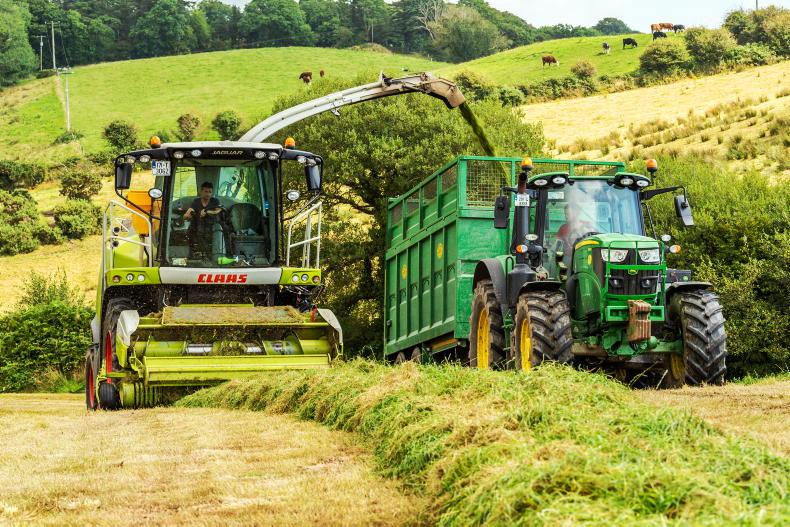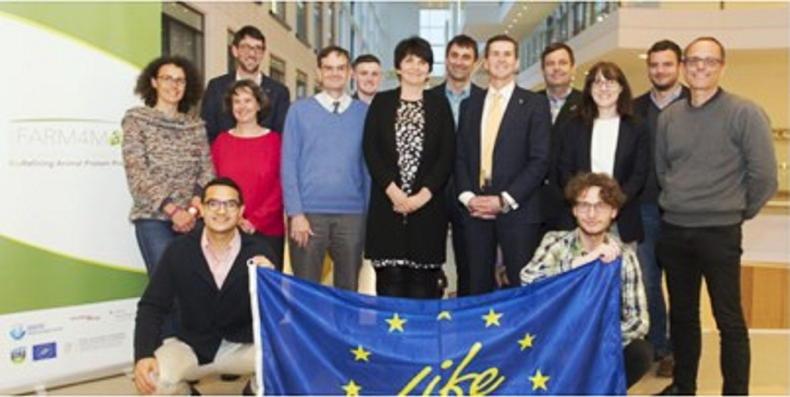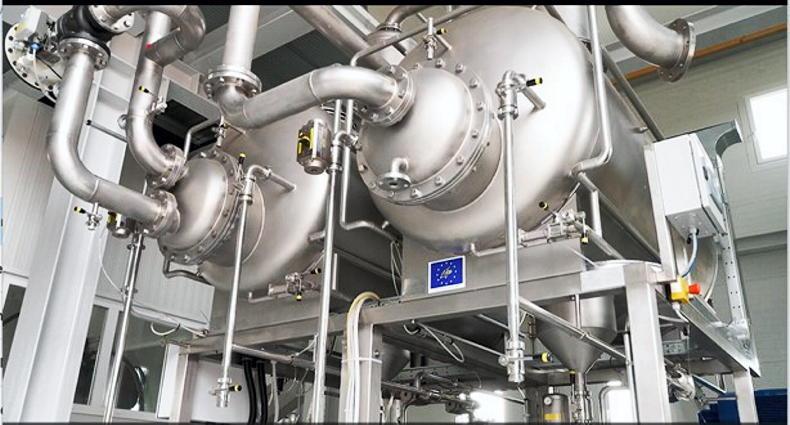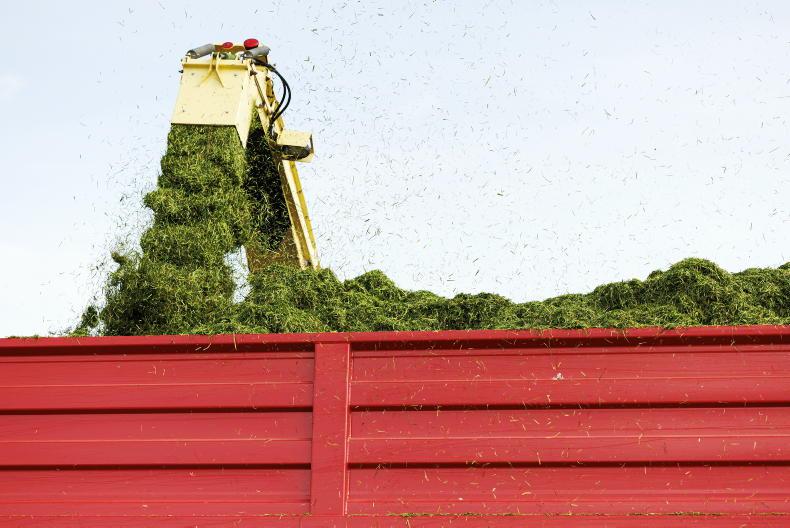Our ability to grow grass is a major competitive advantage. It is high-yielding, perennial, persistent, and can be grown with low chemical nitrogen levels when grown with clover and organic manure.
Grass underpins the success of our dairy sector, in particular. However, grass is also expected to play a significant role in our emerging biomethane and bioeconomy sectors, for many of the same reasons outlined above.
With the imminent launch of the National Biomethane Strategy and likely policy support to allow us to work towards our 2023 target of 5.7 TWh for biomethane, requiring 140 to 200 new anaerobic digestion (AD) plants, a new industry is about to be born.
While AD is nothing new, the type of AD industry Ireland is trying to develop is. The Government wants grass silage to be a significant feedstock. This hasn’t been done to the scale envisaged by the Irish Government anywhere else in the world. This is, in part, to develop a new diversification market for farmers.
Teagasc estimates that, at a national level, the total land area of 120,000ha (less than 3% of available land) will be needed to produce the grass silage to feed the AD biomethane plants required to reach the 5.7 TWh target. This would be added with the slurry as a co-feedstock.
Grass silage
An on-farm 20GWh/yr AD plant will require upwards of 22,000t of silage. This requirement will increase to 44,000t for a non-farm-based plant, 40GWh/yr in size.

Grass grows very well in Ireland.
Grass silage has a reasonably good biogas yield, with one tonne (25% DM) producing between 160m3 and 180m3 of biogas, or 88m3 to 100m3 of biomethane. This, along with its ability to grow fast, recycle digestate and produce high yields make it very attractive as an AD feedstock.
Northern Ireland is a good example of how grass silage can work well for AD, but can also present challenges. Grass silage can also be low in trace elements which cam impact digester performance, although some of these elements will likely be supplied from co-digested slurries.
Grass is high in fibre, meaning it requires a high hydraulic retention time to achieve maximum biogas yields. Hydraulic retention time describes the average number of days that a feedstock stays in a digester.
High-fibre feedstocks can also increase the viscosity of the contents in the digester, making it thicker and semi-fluid in consistency, due to internal friction. This can lead to the formation of dead zones within a digester.
Grass has a velcro-like effect and sticks together if not managed correctly. Equally, if grass isn’t stirred well, it may lead to sedimentation or the formation of swimming layers.
This becomes more likely when digester temperatures are below 40°C but many AD plants using high amounts of grass in Northern Ireland run at higher temperatures.
Poorly ensiled silage or silage that has been spoiled due to mould, can cause a significant problem for biology in a digester and its use should be avoided.
Biorefining
There is considerable work ongoing in Ireland to try and maximise the value of grass silage before it is used as feedstock for AD or livestock. One of the concepts to do this is by biorefining grass.
A biorefinery, a concept garnering increasing attention in the agricultural sector, is the process of converting biomass into valuable products such as food, feed, bio-based materials, chemicals and energy.
In Ireland and Austria, a major new project is under way.

The Farm4more team.
LIFE farm4more is the first Irish-led LIFE climate action project.
It has a budget of €5,494,599 and is co-financed by the Department of the Environment, Climate and Communication. The project is being led by Prof Kevin McDonnell and the research team at University College Dublin.
It aims to achieve climate change mitigation in animal protein production by implementing an economically viable organic grass silage-fed green biorefinery.

The biorefinery unit in Austria.
Protein
The project involves the use of a green pilot biorefinery plant that processes grass silage into high-value protein and amino acid concentrates as feeds for pigs and chickens.
The silage is first rewatered before pressing to bring it to around 22% dry matter. By pressing, this produces around 51% to 57% juice and 40% to 44.5% press cake.
The press cake is used as a ruminant feed, and the juice has been used as a monogastric feed protein additive, but there are higher value-added markets currently being assessed. The press cake has been shown to be an equivalent feedstock to conventional silage albeit with lower digestible protein.

Grass growth is one of Ireland's natural strengths.
The extracted juice has a higher crude protein value than the feed due to its concentration. When fed to cows, the press cake doesn’t impact on milk quality or quantity. The press cake can also be used as feedstock in an AD plant.
An Irish green biorefinery workshop was held at UCD in December 2023. More than 50 key Irish stakeholders were invited.
One of the outcomes of the workshop was the need to address financing and funding opportunities to facilitate the implementation of green biorefinery projects in Ireland and other member states.
A key aspect of this endeavour involves engaging policymakers, presenting tailored evidence of the potential impact of green biorefinery projects, and advocating for supportive policy changes.
Moreover, there’s a need to expand and reinforce the green biorefinery network, fostering collaboration, knowledge sharing and resource pooling to accelerate progress toward a sustainable agricultural future.
This collaborative approach between farmers, scientists and industry experts not only drives innovation but also ensures that solutions are practical, scalable and tailored to the needs of Irish agriculture.
Our ability to grow grass is a major competitive advantage. It is high-yielding, perennial, persistent, and can be grown with low chemical nitrogen levels when grown with clover and organic manure.
Grass underpins the success of our dairy sector, in particular. However, grass is also expected to play a significant role in our emerging biomethane and bioeconomy sectors, for many of the same reasons outlined above.
With the imminent launch of the National Biomethane Strategy and likely policy support to allow us to work towards our 2023 target of 5.7 TWh for biomethane, requiring 140 to 200 new anaerobic digestion (AD) plants, a new industry is about to be born.
While AD is nothing new, the type of AD industry Ireland is trying to develop is. The Government wants grass silage to be a significant feedstock. This hasn’t been done to the scale envisaged by the Irish Government anywhere else in the world. This is, in part, to develop a new diversification market for farmers.
Teagasc estimates that, at a national level, the total land area of 120,000ha (less than 3% of available land) will be needed to produce the grass silage to feed the AD biomethane plants required to reach the 5.7 TWh target. This would be added with the slurry as a co-feedstock.
Grass silage
An on-farm 20GWh/yr AD plant will require upwards of 22,000t of silage. This requirement will increase to 44,000t for a non-farm-based plant, 40GWh/yr in size.

Grass grows very well in Ireland.
Grass silage has a reasonably good biogas yield, with one tonne (25% DM) producing between 160m3 and 180m3 of biogas, or 88m3 to 100m3 of biomethane. This, along with its ability to grow fast, recycle digestate and produce high yields make it very attractive as an AD feedstock.
Northern Ireland is a good example of how grass silage can work well for AD, but can also present challenges. Grass silage can also be low in trace elements which cam impact digester performance, although some of these elements will likely be supplied from co-digested slurries.
Grass is high in fibre, meaning it requires a high hydraulic retention time to achieve maximum biogas yields. Hydraulic retention time describes the average number of days that a feedstock stays in a digester.
High-fibre feedstocks can also increase the viscosity of the contents in the digester, making it thicker and semi-fluid in consistency, due to internal friction. This can lead to the formation of dead zones within a digester.
Grass has a velcro-like effect and sticks together if not managed correctly. Equally, if grass isn’t stirred well, it may lead to sedimentation or the formation of swimming layers.
This becomes more likely when digester temperatures are below 40°C but many AD plants using high amounts of grass in Northern Ireland run at higher temperatures.
Poorly ensiled silage or silage that has been spoiled due to mould, can cause a significant problem for biology in a digester and its use should be avoided.
Biorefining
There is considerable work ongoing in Ireland to try and maximise the value of grass silage before it is used as feedstock for AD or livestock. One of the concepts to do this is by biorefining grass.
A biorefinery, a concept garnering increasing attention in the agricultural sector, is the process of converting biomass into valuable products such as food, feed, bio-based materials, chemicals and energy.
In Ireland and Austria, a major new project is under way.

The Farm4more team.
LIFE farm4more is the first Irish-led LIFE climate action project.
It has a budget of €5,494,599 and is co-financed by the Department of the Environment, Climate and Communication. The project is being led by Prof Kevin McDonnell and the research team at University College Dublin.
It aims to achieve climate change mitigation in animal protein production by implementing an economically viable organic grass silage-fed green biorefinery.

The biorefinery unit in Austria.
Protein
The project involves the use of a green pilot biorefinery plant that processes grass silage into high-value protein and amino acid concentrates as feeds for pigs and chickens.
The silage is first rewatered before pressing to bring it to around 22% dry matter. By pressing, this produces around 51% to 57% juice and 40% to 44.5% press cake.
The press cake is used as a ruminant feed, and the juice has been used as a monogastric feed protein additive, but there are higher value-added markets currently being assessed. The press cake has been shown to be an equivalent feedstock to conventional silage albeit with lower digestible protein.

Grass growth is one of Ireland's natural strengths.
The extracted juice has a higher crude protein value than the feed due to its concentration. When fed to cows, the press cake doesn’t impact on milk quality or quantity. The press cake can also be used as feedstock in an AD plant.
An Irish green biorefinery workshop was held at UCD in December 2023. More than 50 key Irish stakeholders were invited.
One of the outcomes of the workshop was the need to address financing and funding opportunities to facilitate the implementation of green biorefinery projects in Ireland and other member states.
A key aspect of this endeavour involves engaging policymakers, presenting tailored evidence of the potential impact of green biorefinery projects, and advocating for supportive policy changes.
Moreover, there’s a need to expand and reinforce the green biorefinery network, fostering collaboration, knowledge sharing and resource pooling to accelerate progress toward a sustainable agricultural future.
This collaborative approach between farmers, scientists and industry experts not only drives innovation but also ensures that solutions are practical, scalable and tailored to the needs of Irish agriculture.










 This is a subscriber-only article
This is a subscriber-only article











SHARING OPTIONS: